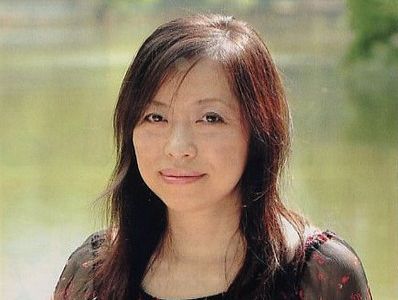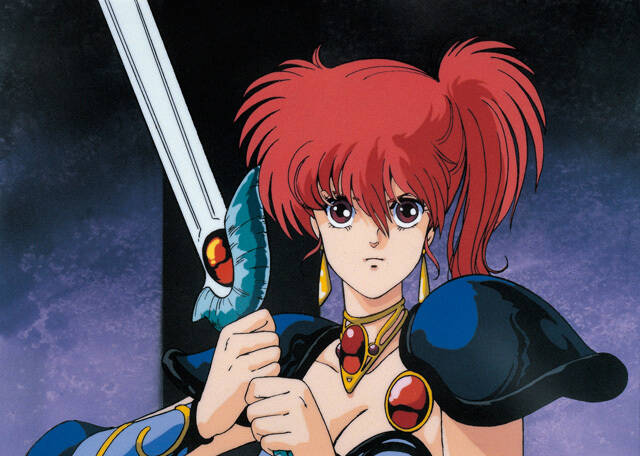Mutsumi Inomata (1960-2024)
March 18, 2024 · 1 comment

The artist Mutsumi Inomata, who died on 10th March, has been a ubiquitous presence in the anime world for the last forty years, even though she distanced herself from actual animation in the late 1980s. When interviewed about her character designs on Weathering Continent in 1993, she admitted that she already had left much of the daily grind of animation work behind years before in favour of life as an illustrator.
“For a long time, I was incredibly attached to animation,” she told Dragon magazine, translated here at Animétudes. “There were still things I had to do, things I wanted to do, and I strongly felt that I hadn’t given my all yet, so I couldn’t imagine leaving. I was still doing key animation here and there as well. But, at some point, I realized that I couldn’t do both at the same time and fully invest myself in either, and I had a hard time choosing. In the end, I decided to stop working in animation and only do illustrations.”
Known to her closest friends as Mutchi, she took a summer job at the animation company Maki Pro while she was still a teenager, finishing artwork on subcontract to Toei Animation. Although she had planned to go to art school, thanks to references from her part-time employer, she was able to join the animation company Ashi Pro straight out of high school in 1978, where she worked on Josefina the Whale.

“At first I thought, ‘Holy smokes, that was way too quick!’” she said in a 2012 interview, (translated here at Heisei Etranger). “Back then, I was also learning oil painting, and I thought anime was in another league. I questioned if you could really just drop out of school and jump right into a job at an art company. So, I asked a teacher at school, and then they asked an acquaintance of theirs who worked in the art industry. They responded, ‘If she can already get a job, then it sounds fine to me.’ I was convinced after that, and I took the full-time job.”
It turns out that inbetweening or colouring are not the lowliest jobs in the animation world after all. Inomata was first put to work as the minion who had to punch sprocket holes in blank cels ready for painting, but proved to be so hapless at it that she was re-assigned, essentially failing up to put her art skills to use. She fast-tracked up through the company, and was soon assigned entire shots to animate on Space Warrior Baldios and Goshogun.

In 1982, she and several other young employees quit Ashi to form their own company, Kaname Production. They worked on other company’s products, like Acrobunch and Sasuga Sarutobi, while pitching their own ideas for a number of other adaptations from well-known manga and novelists, but failed to gain any traction with their proposals to adapt the likes of Monkey Punch and Sakyo Komatsu. The first and only time that Kaname was credited with being the lead showrunner on a TV anime production was on Plawres Sanshiro, a 37-episode series based on a manga by Jiro Gyu, about a sport of “plastic wrestler” robots, controlled by young pilots, whose interface technology was itself the subject of corporate skulduggery and intrigue.
Despite this relatively low visibility on television, Kaname nevertheless was one of the stand-out companies in 1980s anime, thanks largely to Inomata’s strikingly original character designs and artwork, which was often the only element available to magazines covering works in production. She was instrumental in the company’s acquisition and production of Yoshinori Kanada’s manga Birth Planet Busters, which was turned into the seminal straight-to-video Birth, as well as the movie adaptation of Keisuke Fujikawa’s fantasy novel Windaria.
By the time Windaria was released in 1986, Inomata had already left Kaname to go freelance – she would work on many other shows, often for Kaname, but often in the early stages as a character designer or concept artist, for shows including Cyberformula GPX, Delpower X and Brain Powerd. The last brought her into contact with the maverick director and creator Yoshiyuki Tomino, who developed the habit of ringing her doorbell every day on his way home from work to interrogate her: “Inomata! Did you get the script?”

Her association with Fujikawa had gained her the chance to illustrate some of his other novels, but this left her no less visible in Japanese popular culture, with her powerful, big-eyed pastel covers often looking like concept art for an anime already underway. Such an impression was often welcome to both authors and publicists, making Inomata, along with Yoshitaka Amano, one of the go-to illustrators for Japanese fantasy and science fiction novels. From the mid-1980s onwards, Inomata was the queen of the sci-fi bookshelves, with her cover imagery dominating works including Alien Cop by Mariko Ohara, Leda by Kaoru Kurimoto, and KLAN by Yoshiki Tanaka. “Each time I have to draw,” she said, “I just read the novel, follow my own instincts, and all of the sudden the images come out. I don’t think about it again afterwards.”

Inomata’s concentration on single, lavish images allowed her to remain visible ever after. She worked in animation on surprisingly few anime, but her colourful splash paintings, both as book covers and as concept art, remained an everyday sight in anime magazines like Newtype and Animage. Animators might toil for months on a single show, but they could be steered and inspired by a handful of images that Inomata would have provided for them long before production began. By drawing the cover for Keisuke Fujikawa’s Dark Age fantasy Utsunomiko, for example, she effectively qualified herself for first refusal over the job of becoming the character designer of its animated adaptation. Such pieces would become enduring adverts for her talents, leading to her most high-profile fan of all, the pop star Michael Jackson, who saw an Utsunomiko book while in Japan on his “Bad” tour, and summoned Inomata for an audience.
Inomata’s talent for concept art and character design would allow her to hop effortlessly into Japan’s new growth area in 1990s pop culture – computer games. She found an entire new fan base creating cover artwork for Alpha and Arcus Odyssey, which soon repeated her experience from the anime world, as she was co-opted to design the characters for the games themselves, including the visual novel Emit, a 1994 adventure game intended to help Japanese students learn English, and the sprawling Tales of franchise that began with 1997’s Tales of Destiny from Namco.
“She was still working on some roughs when she died,” her sister posted on social media. “And I’m sure she’s still drawing them in heaven, surrounded by her beloved cats, still coming up with new characters with cute, strong eyes!”
Anime4Life
March 23, 2024 2:36 am
Dying before your work is completed is too sad and heartbreaking... But at least dying for something she loved. That's a true warrior